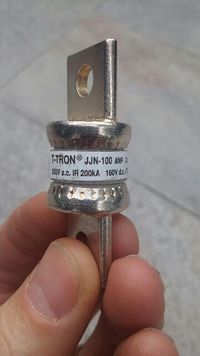The charging circuit has a fuse encapsulated in a cable that protects the battery from charging at too high a rate.
- Affected Circuits
- 2013: the charging fuse acts on the accessory charging port, and does not disable the onboard charger.
- 2014+: the fuse acts on the circuit containing both the accessory charging port and the onboard charger but has a much higher limit.
- Location
- On the right side of the bike under the seat behind the battery, near or under quite a few 12V cable runs.
| Platform | Years | Current Limit (Continuous) | Power Limit (Continuous) | Product |
|---|---|---|---|---|
| X | 2013+ | |||
| S | 2013 | 30A | 3kW | Eaton JJN-30 |
| 2014+ | 100A rated, 85A slow limit | 10kW | Eaton JJN-100 |
- NOTE
- 2013 Battery Pack Longevity Recalls
- The battery pack replacements performed by the manufacturer due to discovered defects wind up being upgrades to 2015 and then 2016 model year power packs, and seem to include upgraded charging circuits, so those older models will have the higher-rated fuse and work like the newer bikes, charging-wise.
- Replacement
-
 Warning:
Warning: This fuse is not meant to be user-serviceable, and could be very dangerous to replace without the exact same specification. - The fuse is downstream from the contactor, so if the contactor is open (it should be if you can't charge and the bike is keyed off), it should be de-energized.
- Verify this with proper testing equipment.
- It's a huge inline fuse within adhesive heat shrink, so it's difficult to extract and replace.
- The wires do have ring terminals once you get the fuse out, so you could wire in a fuse breaker. Or if in a pinch just bolt them together.
- Fuse Part Investigations
- A 2014 SR was found to have an Eaton JJN-100 fuse, a fast-acting fuse rated for 300V and 100A.
- Datasheet for the Eaton JJN-100
- If the 2014 match is correct, a JJN-30 would seem to be the match for a 2013 Zero (same datasheet as above).
- There was supposition of a 60A limit on 2014 motorcycles, implying a TTN-60, but that has not been proven with evidence.
